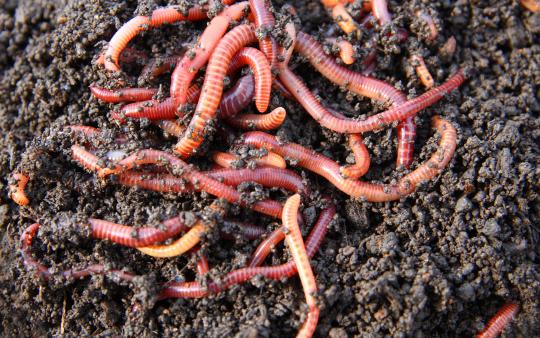After a long, cold winter there is something rejuvenating and comforting in turning over garden beds. With each shovelful, the smell of moist, damp earth rises up and we rejoice in the promise of a new season of growth. And as we turn the soil, we inevitably will come across the first signs of life in spring, in the form of wriggling pink and brown tubes. That’s right—worms! More than just a garden guest, worms are essential to improving soil quality. They enrich the earth with their nitrogen-rich secretions, and mix the subsoil with the topsoil, bringing oxygen and water to the roots of plants and trees as they burrow around! In fact, worms are so crucial to agriculture that when early settlers to Canada and the northern parts of the United States discovered there were no native earthworms, they brought them here in the earthen ballast of ships.
Worms might look like tiny two-headed monsters, but in reality have both a head and a tail (though they look pretty similar!). To find the head, look for a raised band on the body called the clitellum. The head and mouth are located closest to this region (and it’s also the location where worm eggs are formed). Despite what you may have heard, if an earthworm is cut in two, both parts will not survive. The tail end may grow back if the worm is severed below its clitellum, but it isn’t an ideal way to get two worms for the price of one, so please leave your worms in one piece!
Worm-worthy facts!
- Worms are hermaphrodites meaning that have both male and female organs.
- Worms don’t have eyes! Instead they sense light and move away from it, preferring cozy darkness. If a worm is left exposed to light for too long, it will become paralyzed.
- Worms move like an accordion, one body section at a time. Each section has a band of circular muscles and a pair of setae or bristle-like structures that help to grab onto the soil as they wriggle through the earth.
- While they have tiny mouths, worms don’t have teeth. Whatever small bits of food they swallow moves down their intestine, through a gizzard, and eventually passes out as worm poop, or castings, which is great for your garden! The biggest worm in the world, the Gipplsand Earthworm, is found in Australia and can grow to over 12 feet long!
Charm worms right out of the dirt!
Also known as worm fiddling, worm wheedling, or worm grunting, you can coax worms up to the surface by making yourself some worm fiddlesticks. All you need is a pair of hardwood dowels and a little patience! There are competitions throughout the United States and in Canada to find the best worm charmer. Maybe it’ll be you! Want to find out?
Worm wheedling directions
- You’ll need two hardwood dowels – one four feet long and one two feet long, both about three quarters of an inch or so thick. Use a saw to cut horizontal notches every few inches or so in the longer dowel.
- Take your dowels to a moist wooded location. Worms love decaying matter and will congregate where there’s a big buffet! Place one end of the longer dowel upright into the ground. Hold the dowel firmly in place. With the other stick, vigorously rub up and down along the ridges you notched just like a fiddle player playing a jig (it should make a distinctive rasping noise). It may take about five to ten minutes, but those vibrations should bring worms to the surface in no time!









